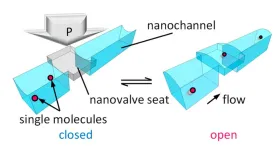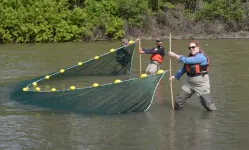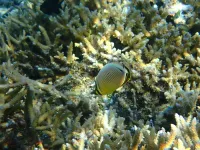Single-molecule valve: a breakthrough in nanoscale control
On the horizon: a paradigm shift revolutionizing chemical and biochemical synthesis
2023-05-02
(Press-News.org)
Scientists dream of using tiny molecules as building blocks to construct things, similar to how we build things with mechanical parts. However, molecules are incredibly small - around one hundred millionth the size of a softball - and they move randomly in liquids, making it very difficult to manipulate them in a single form. To overcome this challenge, “nanofluidic devices” that can transport molecules in extremely narrow channels, similar in size to one millionth of a straw, are attracting attention as a way to directly manipulate single molecules in solutions.
A joint research team led by Associate Professor Yan Xu of the Osaka Metropolitan University Graduate School of Engineering has succeeded in regulating the flow of single molecules in solution by opening and closing a nanovalve in a nanofluidic device by applying external pressure.
The research team fabricated a nanofluidic device with a thin, flexible glass sheet on the top, and a hard glass plate with small structures that forms nanochannels and nanovalve seats on the bottom. By applying external pressure to the flexible glass sheet to open and close the valve, they succeeded in directly manipulating and controlling the flow of individual molecules in solution. They also found that when they trapped single fluorescent molecules in the nanospace inside the valve, the fluorescence of the single molecules became brighter. This happened because the small space made it harder for the single molecules to move around randomly. Professor Xu said that “this effect of fluorescence signal amplification could help with detecting very small amounts of pathogens for early diagnosis of diseases such as cancers and Parkinson's disease, without requiring expensive equipment.”
The findings of this study could be a significant step towards freely assembling materials using single molecules as building blocks in solution. This technology has the potential to be useful in various fields, such as developing personalized medicines for rare diseases and creating better displays and batteries. Its applications are limitless.
“We have been addressing various challenges by proposing and promoting the concept of ‘Single-Molecule Regulated Chemistry (SMRC),’ where molecules are treated as building blocks and all processes involved in chemical and biochemical reactions in solution are performed on a single-molecule basis. The single-molecule valve marks the first step towards the goal, which could one day revolutionize chemistry, biology, and materials science, as well as transform various industries,” said Professor Xu.
Their findings were published in Nano Letters.
Videos
Single-molecule flow of Cy3 in a nanochannel https://youtu.be/p8IpoqEGfQ8
Brownian motion of a single molecule (Cy3) confined in a valve nanospace https://youtube.com/shorts/Xs6X7V2kyBA
###
About OMU
Osaka Metropolitan University is the third largest public university in Japan, formed by a merger between Osaka City University and Osaka Prefecture University in 2022. OMU upholds "Convergence of Knowledge" through 11 undergraduate schools, a college, and 15 graduate schools. For more research news visit https://www.omu.ac.jp/en/ or follow us on Twitter: @OsakaMetUniv_en, or Facebook.
END
ELSE PRESS RELEASES FROM THIS DATE:
2023-05-02
AMHERST, Mass. – Researchers at the University of Massachusetts Amherst and the University of Alaska Anchorage are the first to characterize two different types of surface water in the hyperarid salars—or salt flats—that contain much of the world’s lithium deposits. This new characterization represents a leap forward in understanding how water moves through such basins, and will be key to minimizing the environmental impact on such sensitive, critical habitats.
“You can’t protect the salars if you don’t first understand how they work,” says Sarah McKnight, lead author of the research that appeared recently ...
2023-05-02
Embargoed for release until 5:00 p.m. ET on Monday 01 May 2023
Annals of Internal Medicine Tip Sheet
@Annalsofim
Below please find summaries of new articles that will be published in the next issue of Annals of Internal Medicine. The summaries are not intended to substitute for the full articles as a source of information. This information is under strict embargo and by taking it into possession, media representatives are committing to the terms of the embargo not only on their own behalf, but also on behalf of the organization they represent.
----------------------------
1. ...
2023-05-02
Climate change has led to earlier spring blooms for wildflowers and ocean plankton but the impacts on salmon migration are more complicated, according to new research.
In a new study, published in the journal Nature, Ecology & Evolution, Simon Fraser University (SFU) researcher Sam Wilson led a set of diverse collaborators from across North America to compile the largest dataset in the world on juvenile salmon migration timing. The dataset includes 66 populations from Oregon to B.C. to Alaska. Each dataset was at least 20 years in length with the longest dating back to 1951. Only wild salmon, and not salmon from hatcheries, ...
2023-05-02
ANN ARBOR, Mich. – In recent years, experts have debated whether most birthing individuals would benefit from labor induction once they reach a certain stage of pregnancy.
But a new statewide study in Michigan suggests that inducing labor at the 39th week of pregnancy for people having their first births with a single baby that is in a head down position, or low risk, doesn’t necessarily reduce the risk of caesarian births. In fact, for some birthing individuals, it may even have the opposite effect if hospitals don’t take a thoughtful approach to ...
2023-05-02
BEND, Ore. – A researcher at Oregon State University-Cascades has received funding to develop a smart compost bin that tracks household food waste.
The project led by Patrick Donnelly, assistant professor of computer science in the OSU College of Engineering, seeks to make a dent in a multi-billion-dollar annual problem in the United States: More than one-third of all food produced in the U.S. goes uneaten.
“At every other step of the agricultural supply chain, food waste is tracked, measured and quantified,” Donnelly ...
2023-05-02
DALLAS, May 1, 2023 — Science tells us that when a cardiac arrest happens, bystander CPR can double or even triple the chances of survival.[1] Asian American and Pacific Islander (AAPI) adults who experience cardiac arrest outside of a hospital setting have a substantially lower chance of receiving bystander CPR.[2] During Asian American Pacific Islander Heritage month in May, the American Heart Association, a global force for healthier lives for all, is asking people to “Be the Beat” for their family and learn Hands-Only ...
2023-05-02
DALLAS, May 1, 2023 — Strokes can happen to anyone, at any age. In fact, globally about one in four adults over the age of 25 will have a stroke in their lifetime.[1] During American Stroke Month, the American Stroke Association, a division of the American Heart Association, as part of a nationally supported collaboration with HCA Healthcare and the HCA Healthcare Foundation, will teach people everywhere that stroke is largely preventable, treatable and beatable.
A stroke happens when normal blood flow in the brain is interrupted. When parts of the ...
2023-05-02
AUGUSTA, Ga. (May 2, 2023) – Inhibiting a tiny RNA whose levels significantly increase with age, along with problems like weaker bones and sagging muscles, may be a way to keep our bodies more youthful and healthy, scientists say.
MicroRNAs help regulate gene expression and consequently the function of our cells, and several, including one called microRNA-141-3p, have been implicated in the ills of aging, like increasing levels of potentially damaging chronic inflammation and that shrinking muscle mass.
“When we age in all these complications like chronic inflammation, muscle loss, bone loss, this microRNA is elevated,” says Sadanand ...
2023-05-02
HOUSTON – (May 2, 2023) – Feces from fish that are typically thought to promote healthy reefs can damage and, in some cases, kill corals, according to a recent study by Rice University marine biologists.
Until recently, fish that consume algae and detritus — grazers — were thought to keep reefs healthy, and fish that eat coral — corallivores — were thought to weaken reef structures. The researchers found high levels of coral pathogens in grazer feces and high levels of beneficial bacteria in corallivore feces, which they say could act like a “coral probiotic.”
“Corallivorous ...
2023-05-01
New findings in color vision research imply that humans can perceive a greater range of blue tones than monkeys do.
“Distinct connections found in the human retina may indicate recent evolutionary adaptations for sending enhanced color vision signals from the eye to the brain,” researchers report April 25 in the scientific journal, Proceedings of the National Academy of Sciences.
Yeon Jin Kim, acting instructor, and Dennis M. Dacey, professor, both in the Department of Biological Structure at the University of Washington School of Medicine in Seattle, led the international, collaborative project.
They were joined ...
LAST 30 PRESS RELEASES:
[Press-News.org] Single-molecule valve: a breakthrough in nanoscale control
On the horizon: a paradigm shift revolutionizing chemical and biochemical synthesis







